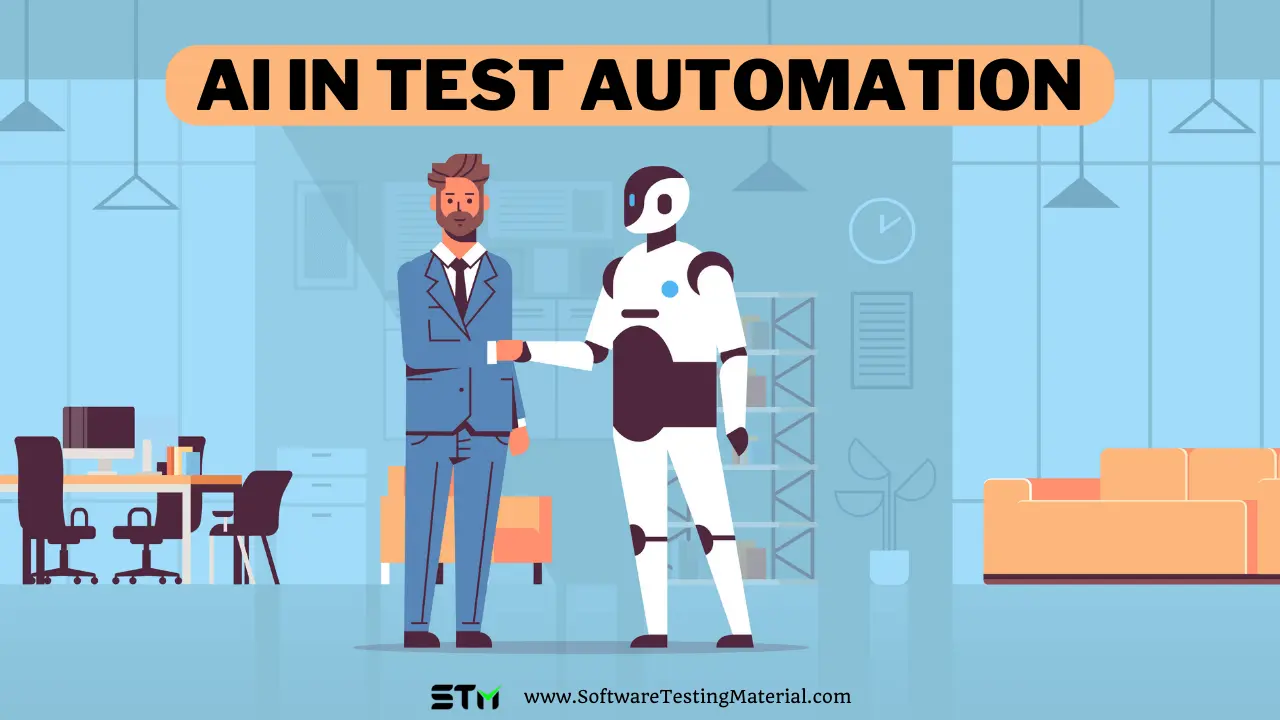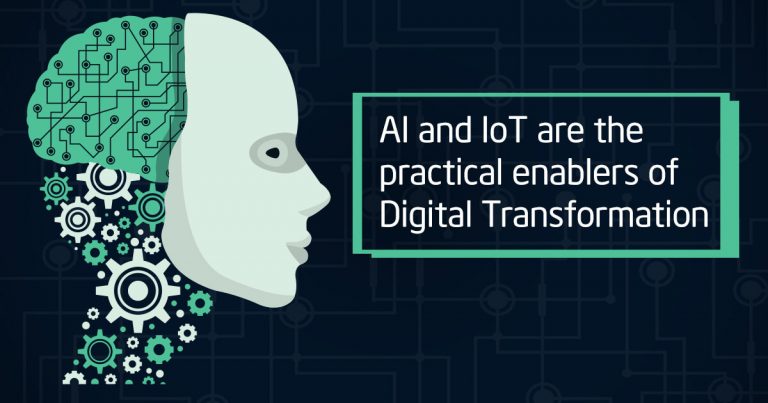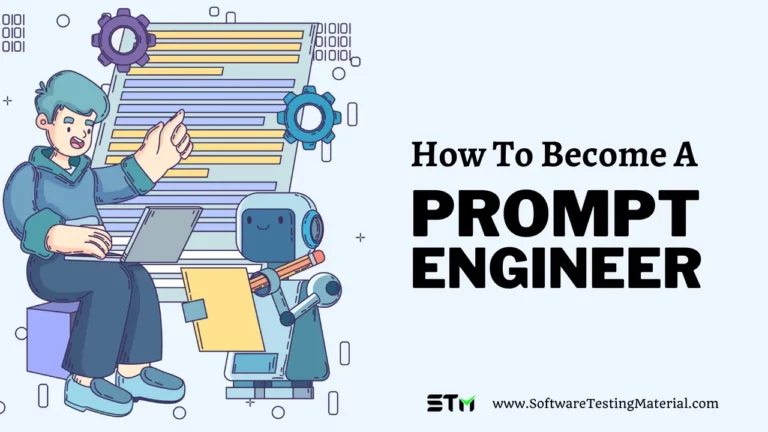Unveiling the Power of AI in Test Automation: A Comprehensive Guide
When we hear the term “Artificial Intelligence” (AI), our minds often conjure up images of futuristic robots and sci-fi marvels. However, AI has already seamlessly integrated into our daily lives, transforming our smartphones, televisions, and even our homes to simplify everyday tasks.
Dont’ miss: Best ways to build career in Artificial Intelligence
In the realm of software testing, the power of AI can revolutionize your testing initiatives by boosting efficiency and productivity. While some may view “AI in testing” with skepticism, it holds the potential to deliver tangible benefits and streamline your testing efforts.
But let’s delve deeper. What exactly is AI, and what lies ahead for this groundbreaking technology? More importantly, how can it optimize the realm of software testing? Join us as we embark on an enlightening journey to uncover the untapped potential of AI in test automation.

Bridging the Gap: The AI Hype vs Reality
In recent years, Artificial Intelligence (AI) has become a buzzword in various industries, including software testing. However, amidst the hype and excitement surrounding AI, it is essential to separate fact from fiction and gain a clear understanding of its true potential in test automation.
Debunking common misconceptions surrounding AI in test automation:
Misconception #1: AI in test automation replaces human testers entirely
Reality: AI in test automation is not meant to replace human testers but rather augment their capabilities. While AI can automate repetitive and mundane tasks, human testers are still essential for critical thinking, test strategy, and interpreting results.
Read Also: What is Data Loss Prevention (DLP)?
Misconception #2: AI can perform testing without any human intervention
Reality: AI requires human involvement throughout the testing process. Humans are responsible for training AI models, validating and curating data, and providing domain expertise. AI complements human testers by automating certain tasks and assisting in decision-making.
Misconception #3: AI can solve all testing challenges and guarantee bug-free software
Reality: AI is a powerful tool, but it is not a silver bullet. It can help improve test coverage, identify patterns, and accelerate testing. However, it cannot completely eliminate the need for human judgement and creativity. Bugs can still occur, and human testers are required to analyze complex scenarios and edge cases.
Examining the real-world benefits and practical implications of AI:
Real-world benefit #1: Increased test coverage and efficiency
AI can generate a vast number of test cases based on machine learning algorithms and historical data. This significantly enhances test coverage, ensuring that a wide range of scenarios are tested. AI can also automate repetitive tasks, reducing the time and effort required for testing.
Real-world benefit #2: Improved defect detection and accuracy
AI-powered algorithms can analyze large amounts of test data and identify patterns that humans might miss. By learning from historical test results and user feedback, AI can detect defects and anomalies more effectively, leading to higher accuracy in bug detection.
Real-world benefit #3: Faster time-to-market and reduced testing costs
AI in test automation can speed up the testing process by automating test case generation, execution, and analysis. This enables faster feedback loops, allowing organizations to release software faster without compromising quality. Moreover, AI-driven testing reduces the reliance on manual testing, resulting in cost savings in terms of resources and time.
Real-world benefit #4: Enhanced scalability and adaptability
AI-based test automation tools can easily scale to handle large and complex software systems. They can adapt to changes in the application under test, making them suitable for agile development environments where frequent changes and updates occur. AI enables organizations to maintain testing efficiency even as software systems evolve.
Leveraging Machine Learning for Test Creation
Machine learning techniques have revolutionized various fields, and test automation is no exception. Machine learning algorithms can be harnessed to generate test cases, enhancing the efficiency and effectiveness of the testing process. By analyzing data and patterns, machine learning can identify relevant test scenarios and generate test cases that provide comprehensive coverage.
Exploring how machine learning techniques can generate test cases
Machine learning algorithms can leverage historical test data, code repositories, and user feedback to extract valuable insights and patterns. By analyzing this information, machine learning models can identify common paths, critical functionalities, and potential vulnerabilities within the software. These models can then generate test cases that focus on covering these areas, ensuring thorough testing coverage.
Utilizing data-driven approaches to improve test coverage and accuracy
Data-driven approaches play a crucial role in enhancing test coverage and accuracy. By utilizing machine learning algorithms, organizations can leverage data from various sources, including user behavior, real-world usage patterns, and production logs. These data sources provide valuable information for identifying potential edge cases and scenarios that may have been overlooked in traditional test design.
Machine learning algorithms can analyze and process this data, identifying patterns, dependencies, and areas of high risk. This enables the creation of test cases that target critical functionalities and edge conditions, improving overall test coverage. By incorporating data-driven approaches, organizations can ensure that their testing efforts align with real-world usage scenarios, thereby increasing the accuracy and effectiveness of their tests.
Additionally, machine learning can assist in test case prioritization by identifying the most critical test scenarios based on historical data and the potential impact on the system. This prioritization enables optimization of testing efforts, ensuring that high-risk areas are thoroughly tested while also considering time and resource constraints.
Exploring Test Automation Tools with Machine Learning Capabilities
When it comes to test automation, harnessing the power of machine learning can greatly enhance the efficiency and accuracy of your testing efforts. Below, we have compiled a list of top-notch test automation frameworks & tools that leverage machine learning techniques to conduct and track automated tests.
Detailed Guide: Best Artificial Intelligence Test Automation Tools
These tools offer a range of features and options to cater to the diverse needs of your testing team.
#1. Applitools Eyes
Standout Features: Applitools Eyes utilizes AI and machine learning algorithms to perform visual validation of your application’s user interface across different browsers, devices, and screen resolutions. It can detect visual bugs and provide visual AI-powered analysis for test result comparisons.
Unique Selling Point: Applitools Eyes empowers your testing team to identify visual discrepancies in the UI, improving the overall quality and user experience of your software applications.
#2. Functionize
Standout Features: Functionize leverages machine learning to enable codeless test automation. It utilizes AI to self-heal and adapt test scripts, making them resilient to changes in the application under test. It also offers natural language processing (NLP) for creating test cases in a human-readable format.
Unique Selling Point: Functionize allows non-technical users to create and maintain automated tests without writing code, enhancing the collaboration between testers and developers.
#3. Parasoft SOAtest
Standout Features: Parasoft SOAtest combines AI and machine learning to create intelligent API tests. It offers automatic test case generation based on API contracts and usage patterns. It can also identify performance and security vulnerabilities through its machine learning-driven analysis.
Unique Selling Point: Parasoft SOAtest focuses on API testing and provides advanced test generation capabilities, ensuring that your APIs are thoroughly tested for functionality, performance, and security.
#4. Mabl
Standout Features: Mabl is an AI-driven test automation tool that uses machine learning to analyze your application’s behavior and generate intelligent test cases. It provides self-healing capabilities to adapt tests to application changes automatically. It also offers built-in integrations with popular CI/CD pipelines.
Unique Selling Point: Mabl streamlines the test creation process by automatically identifying critical areas of your application to test, enabling efficient and comprehensive test coverage.
#5. Test.ai
Standout Features: Test.ai leverages AI and machine learning to provide autonomous testing capabilities. It uses computer vision algorithms to explore and test applications like a human user, identifying and reporting issues automatically. It can also generate test scripts based on app exploration.
Unique Selling Point: Test.ai offers a unique approach to testing by mimicking human exploration and interaction with the application. This enables efficient test coverage and early defect detection.
Unraveling the Role of AI in Test Automation
As Artificial Intelligence (AI) continues to advance, it is playing an increasingly vital role in test automation. AI complements traditional test automation techniques by enhancing efficiency, expanding test coverage, and improving the accuracy of test results. Understanding the role of AI in test automation and identifying scenarios where it can add value is crucial for harnessing its full potential.
Complementing Traditional Test Automation Techniques
AI serves as a powerful ally to traditional test automation techniques by offering additional capabilities that enhance the overall testing process. While traditional test automation relies on predefined scripts and rules, AI brings intelligence and adaptability to testing.
It can analyze vast amounts of data, learn from patterns and anomalies, and make informed decisions based on the context. This ability to learn and adapt enables AI to uncover defects and vulnerabilities that may go unnoticed in traditional scripted tests.
Expanding Test Coverage
AI excels at generating test cases and scenarios that cover a wide range of possible inputs, configurations, and user behaviors. By leveraging machine learning algorithms, AI can explore and analyze data to identify critical paths, edge cases, and potential risks within the software system. This enables the creation of test cases that provide extensive coverage, ensuring thorough testing across various dimensions and reducing the risk of undiscovered issues.
Improving Test Accuracy
AI-powered testing tools can analyze test results, identify patterns, and detect anomalies more effectively than manual inspection. Machine learning algorithms can learn from historical data and use that knowledge to validate test outcomes, leading to higher accuracy in bug detection and reducing false positives and false negatives. AI can also assist in pinpointing the root causes of failures by correlating various factors and providing valuable insights for troubleshooting.
Scenarios where AI adds value to the testing process
a. Complex and rapidly changing applications: AI shines in scenarios where applications are intricate, evolving rapidly, or have a high degree of variability. AI can adapt to changes and handle complex scenarios more efficiently than traditional methods.
b. Large-scale testing: When dealing with a large number of test cases, AI can automate test generation, execution, and analysis, significantly reducing manual effort and time required for testing.
c. Data-driven testing: AI can leverage data from different sources, such as user behavior, logs, and production data, to generate test cases and identify critical areas for testing, ensuring alignment with real-world usage scenarios.
d. Performance and load testing: AI can simulate realistic user loads and behaviors, enabling performance testing under various scenarios and providing insights into system scalability and response times.
e. Regression testing: AI-powered tools can efficiently identify impacted areas and prioritize tests based on the impact analysis, allowing testers to focus on critical areas affected by changes.
Real-World Applications of AI in Test Automation
Artificial Intelligence (AI) has found its way into various domains of test automation, revolutionizing the way organizations approach software testing. By leveraging AI’s capabilities, businesses have witnessed significant improvements in test efficiency, accuracy, and effectiveness. Let’s explore some diverse domains where AI is making waves in test automation and examine a few case studies that highlight successful implementations of AI-driven testing.
E-commerce and Retail
AI is reshaping test automation in e-commerce and retail sectors by enabling intelligent testing of complex web applications and ensuring a seamless customer experience. AI-powered test automation tools can perform visual validation, verifying the correctness of web layouts, product images, and pricing information. These tools also employ machine learning algorithms to identify anomalies and patterns in user behavior, enabling better test coverage and enhancing the overall quality of e-commerce platforms.
Web Design and Development
AI is also making significant strides in the domain of web design and development, enhancing the efficiency and quality of testing processes. Web design companies are leveraging AI-powered test automation tools to streamline website testing, ensuring optimal performance across different browsers, devices, and screen sizes.
These tools use machine learning algorithms to automatically identify layout issues, broken links, and compatibility issues, saving time and effort in manual testing.
By automating repetitive tasks and providing comprehensive test coverage, AI in test automation enables web design companies to deliver high-quality websites that meet the expectations of clients and end-users.
Financial Services
In the financial services sector, AI is transforming test automation by improving security, compliance, and risk management. AI-driven tools can simulate and detect fraudulent activities, validate data integrity, and perform extensive regression testing on critical financial systems. These tools leverage machine learning techniques to learn from historical data, identify anomalies, and predict potential issues, enabling organizations to mitigate risks proactively.
Healthcare and Life Sciences
AI is playing a pivotal role in test automation for healthcare and life sciences applications, ensuring the reliability and safety of medical software. AI-driven testing tools can validate the accuracy of medical algorithms, perform robust testing of electronic health records (EHR) systems, and automate the testing of complex medical devices. By harnessing AI’s capabilities, healthcare organizations can improve patient outcomes and minimize risks associated with software failures.
Overcoming Challenges and Considerations
While AI brings numerous benefits to test automation, there are certain challenges and limitations that organizations must address to maximize its effectiveness:
Data quality and diversity
AI models heavily rely on quality and diverse training data. Organizations should ensure that the data used for training AI models represents various scenarios, edge cases, and user behaviors. Data validation and curation processes are essential to prevent biased or skewed models.
Expertise and skills
AI in test automation requires skilled professionals who understand both testing principles and AI techniques. Organizations should invest in training their testing teams to develop expertise in AI technologies and methodologies to effectively implement and utilize AI-driven testing tools.
Transparency and explainability
AI algorithms can be complex, making it challenging to understand how they reach specific conclusions. Organizations should strive for transparency and explainability in AI-powered test automation, ensuring that decisions made by AI models can be justified and interpreted by human testers.
Test environment complexity
Complex test environments with diverse technologies, platforms, and integrations can pose challenges for AI in test automation. Organizations should carefully design test environments and consider factors such as compatibility, data privacy, security, and system interdependencies to ensure AI-powered testing is effective.
Best Practices and Strategies to Maximize Effectiveness
To maximize the effectiveness of AI-powered testing, organizations can follow these best practices and strategies:
Start with a clear test automation strategy
Define the goals, objectives, and scope of your test automation efforts. Identify areas where AI can add the most value and align your testing strategy accordingly.
Identify suitable use cases
Assess your testing requirements and identify scenarios where AI can provide the most significant benefits. Prioritize use cases based on complexity, impact, and potential ROI to ensure targeted implementation.
Invest in quality training data
Acquire and curate high-quality training data that represents the diversity of your software application. Incorporate real-world scenarios, edge cases, and user behaviors to train AI models effectively.
Continuously validate and refine AI models
Regularly validate and fine-tune AI models using feedback from human testers and real-world testing data. Iteratively refine the models to improve accuracy, coverage, and adaptability.
Foster collaboration between AI and human testers
Encourage collaboration and knowledge sharing between AI-driven tools and human testers. Human testers provide critical domain expertise, context, and creativity, while AI assists in automating repetitive tasks and analyzing vast amounts of data.
The Future of AI in Test Automation
The trajectory of AI in test automation holds great potential for further advancements and transformative changes in the testing landscape. Some emerging trends and potential advancements include:
Intelligent test generation
AI will continue to evolve in generating intelligent test cases by leveraging techniques such as natural language processing, deep learning, and reinforcement learning. This will enable the creation of highly targeted and efficient test suites.
Predictive analytics and proactive testing
AI-powered analytics will enable organizations to predict potential defects and areas of risk, allowing for proactive testing and mitigation. Machine learning algorithms will learn from historical data, trends, and system behavior to provide insights into testing priorities.
Autonomous test execution and self-healing systems
AI-driven test automation frameworks will evolve to include autonomous test execution capabilities. Self-learning systems will automatically adapt test cases, configurations, and environments, leading to self-healing testing systems that can handle dynamic software changes.
Ethical considerations and responsible AI
As AI in test automation becomes more prevalent, ethical considerations such as data privacy, algorithmic fairness, and bias mitigation will gain prominence. Organizations will focus on adopting responsible AI practices and ensuring transparency, accountability, and fairness in their AI-driven testing processes.
Conclusion
In conclusion, the power of AI in test automation is undeniable. It has the potential to revolutionize the way software testing is conducted, enhancing efficiency, accuracy, and overall effectiveness. By complementing traditional test automation techniques, AI can address the limitations and challenges of manual testing and provide tangible benefits across diverse domains.
Author Bio
Irfan Rehman is a renowned tech entrepreneur and CEO of ClickySoft. With a deep expertise in testing, business development, and the latest AI developments, he has been at the forefront of driving innovation in the software industry. Irfan’s passion for leveraging AI in test automation has helped organizations optimize their testing processes and achieve greater efficiency and accuracy. His insights and leadership have made him a respected figure in the field, inspiring others to embrace the power of AI in software testing.






